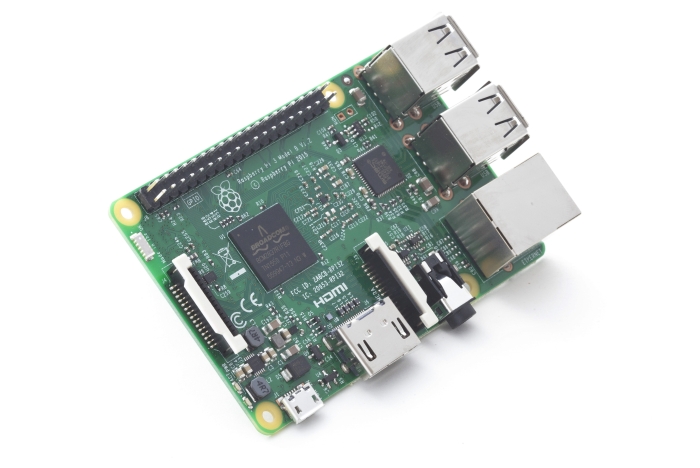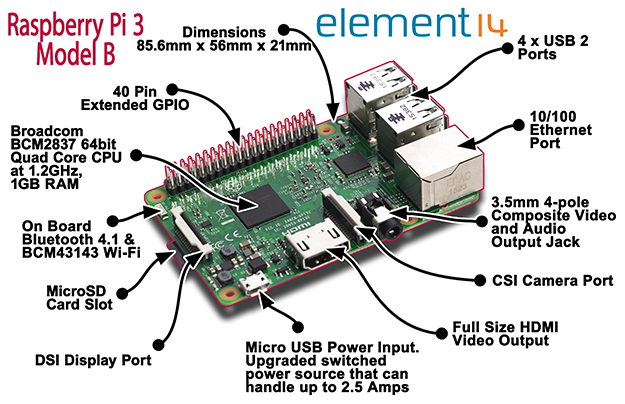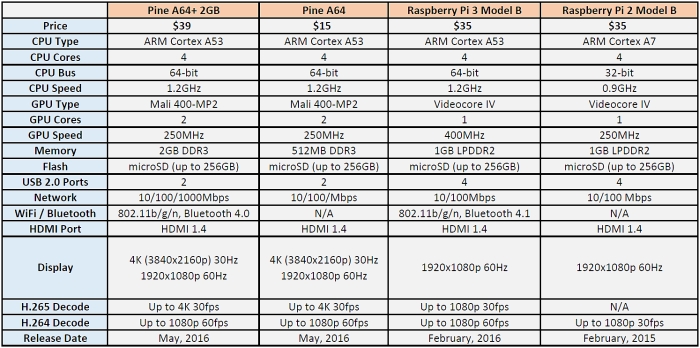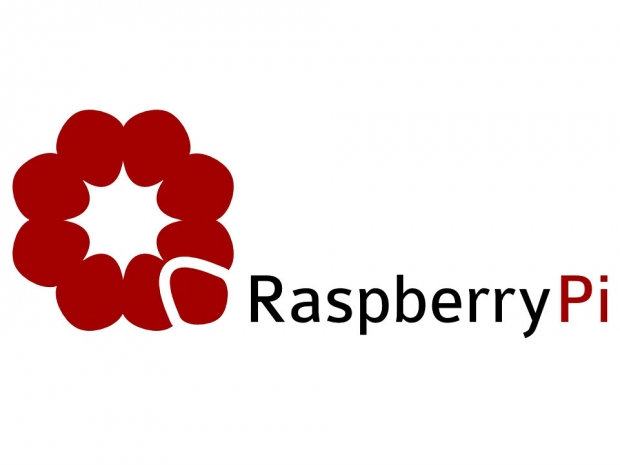
Raspberry Pi 3 Model B (2016)
The Raspberry Pi 3 Model B (2016) succeeds the company’s Raspberry Pi 2 Model B, released in February 2015, at the same $35 introductory price and features a 1.2GHz quad-core ARM Cortex A53 64-bit CPU (Broadcom BCM2387), an updated 400MHz Broadcom VideoCore IV GPU (but still only capable of 1080p), and up to 1GB of RAM. Other specifications include 802.11b/g/n WiFi, Bluetooth 4.1 (Bluetooth Classic and LE), a 10/100 Ethernet port, a full size HDMI 1.4 port (1920x1200 and 1080p60), a 3.5mm composite video and audio output jack, a microSDHC card slot, four USB 2.0 ports, 40-pin Extended GPIO, a DSI display port, a CSI camera port and a 2.5A Micro USB port for more power delivery (up from 800mA).
Image Source: Element14.com
The Raspberry Pi 3 board measures in at 85.6mm x 56mm x 21mm (3.37 x 2.20 x 0.83 inches), the same dimensions as the Raspberry Pi 2.
The Raspberry Pi Foundation claims that its new Raspberry Pi 3 Model B board is roughly 10 times the performance of the Raspberry Pi 1 (2012). The Raspberry Pi 3 also manages roughly 50 to 60 percent more performance over the Raspberry Pi 2 (2015) when used in 32-bit mode. This is achieved by a 33 percent increase in clock speed with various architectural enhancements on the new Broadcom BCM2837.
“The new SoC retains the same basic architecture as its predecessors BCM2835 and BCM2836, so all those projects and tutorials which rely on the precise details of the Raspberry Pi hardware will continue to work. The main reason we're excited about Cortex A53 is it's a better 32-bit processor [than A7]. You can run in 32-bit mode,” said Eben Upton, Raspberry Pi creator.” 64-bit ARM processors also support a new ARMv8 instruction set that’s capable of speeding up both 32-bit and 64-bit operations.”
James Adams spent the second half of 2015 designing a series of prototypes, incorporating BCM2837 alongside the BCM43438 wireless “combo” chip. He was able to fit the wireless functionality into very nearly the same form-factor as the Raspberry Pi 1 Model B+ and Raspberry Pi 2 Model B; the only change is to the position of the LEDs, which have moved to the other side of the SD card socket to make room for the antenna. Roger Thornton ran the extensive (and expensive) wireless conformance campaign, allowing us to launch in almost all countries simultaneously. Phil Elwell developed the wireless LAN and Bluetooth software.”
The foundation has sold over 8 million units of its credit-card sized single-board computers around the world. Starting with just a handful of volunteers, the Raspberry Pi Foundation has grown to over sixty full-time employees and has taken the Raspberry Pi to teachers around the world through its Picademy program and even to the International Space Station.
The first Raspberry Pi was first launched in February 2012 at a $25 introductory price with a 700MHz single-core ARM1176 32-bit CPU, a Broadcom VideoCore IV GPU (1080p) and up to 512MB of RAM. The second-generation Raspberry Pi 2 (and Raspberry Pi 2 Model B) was launched in February 2015 at a $35 introductory price and features a 900MHz quad-core Cortex A7 32-bit CPU, a Broadcom VideoCore IV GPU and up to 1GB of RAM. A significantly cheaper, half-size model, the Rasperry Pi Zero, was launched in November 2015 at a $5 introductory price with a 1GHz single-core ARM1176 32-bit CPU and 512MB of RAM.
Competition heats up between Raspberry Pi 3 and Pine A64+
Meanwhile, a Kickstarter project called Pine64 has just launched its own native 64-bit competitor to the Raspberry Pi 3 for just half the price. The Pine A64 is the world’s first single-board computer with a $15 base price and features the same 1.2GHz quad-core ARM A53 64-bit CPU architecture, however it features a much more capable dual-core MALI 400 MP2 GPU that runs at 250MHz x 2. This is capable of 1.1 gigapixels of throughput, or slightly higher than first-generation Xbox performance. With these specifications and up to 2GB of RAM, the Pine A64 can support both 4K Ultra HD 3840x2160p resolution at 30Hz or 1920x1080p at 60Hz, while the Raspberry Pi 3 can only do 1080p at 60Hz.
Pine 64’s base model does not come with integrated WiFi or Bluetooth, however, and only features 512MB of RAM. The upgrade to 1GB of RAM, 802.11b/g/n WiFi and Bluetooth 4.0 brings the total to $29, which is still lower than the Raspberry Pi’s $35 and offers a more capable GPU with 4K output over HDMI 1.4. On the other hand, the Pine A64+ model with 2GB of RAM is $39, just $4 more than the Raspberry Pi 3.
The Pine A64 will not be shipping to new customers outside the company’s Kickstarter backers until at least May, giving the Raspberry Pi 3 a two-month head start when it goes on sale later this week.
Raspberry Pi 3 supported OSes, Pricing and Availability
In order to retain backward compatibility with a majority of independent projects, the Raspberry Pi 3 will support the same 32-bit Debian-based Raspbian Jessie OS (February 2016) featured on other Pi devices. The Raspberry Pi Foundation will begin evaluating the viability of switching to 64-bit mode over the next few months. The foundation alternatively recommends the NOOBS (New Out of the Box Software) operating system containing Raspbian which can be downloaded here. Other supported Raspberry Pi operating systems include Chromium OS, Gentoo, PiBang, Risc OS, Raspbmc, Slackware ARM, Void Linux, and Windows 10 IoT Core.
The Raspberry Pi 3 Model B (2016) is available for pre-order from Element14 (US), RS Components (UK), ThePiHut (UK) and other resellers at the same $35 / £30 price as the Raspberry Pi 2 Model B (2015) and is expected to begin shipping over the next week.




